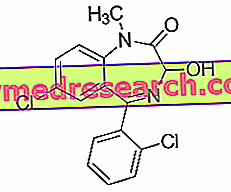Lormetazepam is a sedative-hypnotic drug belonging to the benzodiazepine class.
Indications
For what it uses

Lormetazepam - Chemical Structure
Lormetazepam is indicated for the short-term treatment of insomnia, especially when insomnia is on an anxious basis.
Warnings
Extreme caution should be used when administering lormetazepam in patients with a history of alcohol and / or drug abuse.
Lormetazepam should not be used in children and adolescents under 18 years of age.
Due to the side effects of lormetazepam, in elderly patients treated with the drug, there is an increased risk of falls and consequent fractures.
Care should be taken with the administration of lormetazepam in patients with spinal or cerebellar ataxia.
Since lormetazepam can cause respiratory depression, a reduction in the administered dose may be required in patients with chronic respiratory failure.
A lot of caution should be used when administering lormetazepam in patients with hepatic and / or renal insufficiency.
Lormetazepam greatly influences the ability to drive or use machines.
After repeated use and for a long time, tolerance to lormetazepam may develop. In other words, the hypnotic effects induced by the drug itself can be reduced.
Alcohol consumption should be avoided during lormetazepam therapy.
Interactions
The combination of lormetazepam and other psychiatric drugs requires careful surveillance by the doctor to identify the occurrence of any side effects.
Particular caution should be used in the co-administration of lormetazepam and other medicinal products that suppress respiratory function, such as - for example - opioid drugs.
Concomitant use of lormetazepam and opioid analgesics may increase euphoria which in turn leads to an increase in psychic dependence.
The effects induced by lormetazepam may be increased by concomitant administration of the following drugs:
- Antipsychotic drugs;
- Other hypnotic, anxiolytic, sedative or tranquilizing drugs;
- Some antidepressant drugs;
- Opioid analgesics and anesthetics ;
- Anti- seizure and antiepileptic drugs;
- Sedative antihistamine drugs;
- Β-blocking drugs.
Lormetazepam is able to increase the plasma concentration of cardioactive glycosides .
The effect of lormetazepam may be decreased by concomitant administration of methylxanthines (such as theophylline, theobromine and caffeine), aminophylline or rifampicin (an antibiotic).
Concomitant administration of lormetazepam and oral contraceptives may reduce the plasma concentration of lormetazepam itself.
Concomitant use of lormetazepam and clozapine (an antipsychotic) may induce marked sedation, hypersalivation and ataxia.
Side effects
Lormetazepam can induce various side effects, although not all patients experience them. This is due to the different sensitivity that each individual has towards the drug.
The following are the main side effects that can occur during treatment with lormetazepam.
Addiction
Lormetazepam can lead to the development of physical and mental dependence. The risk of developing dependence is directly proportional to the dose of drug administered and to the duration of the treatment.
Patients who have abused alcohol and drugs are at greater risk of developing addiction.
Once physical dependence is established, abrupt cessation of treatment causes withdrawal symptoms. These symptoms are:
- Depression;
- derealization;
- depersonalization;
- Anxiety;
- Confusion;
- Nervousness;
- Restlessness;
- Irritability;
- Hallucinations;
- Epileptic shocks;
- Rebound insomnia;
- Mood changes;
- Sweating;
- Diarrhea;
- Headache;
- Muscle pains;
- Hypersensitivity and intolerance to sounds (hyperacusis);
- Hypersensitivity to light and physical contact.
Therefore, it is advisable to gradually stop the therapy.
Amnesia
Treatment with lormetazepam can cause anterograde amnesia.
This type of amnesia usually develops within hours of taking the drug. Therefore, patients - after taking lormetazepam - should be able to sleep continuously for at least 8 hours.
Memory can be compromised if the patient wakes up at the time of maximum activity of the drug.
Rebound insomnia
Rebound insomnia may occur upon completion of lormetazepam treatment. In other words, there is an aggravated return of the symptoms (insomnia) that made it necessary to use the drug.
Since rebound symptoms are more frequent when treatment is stopped abruptly, gradual interruption of therapy is recommended.
Psychiatric disorders
Following the use of lormetazepam, so-called paradoxical symptoms may develop. These symptoms are:
- Restlessness;
- agitation;
- Irritability;
- Aggression;
- Anger;
- Anger;
- Psychosis;
- Delusions;
- Hallucinations;
- Nightmares;
- Disappointment;
- Changes in behavior.
Furthermore, lormetazepam can cause other psychiatric disorders, such as depression and anxiety, and can promote the onset of suicidal ideation and behavior.
Nervous system disorders
Lormetazepam therapy may cause:
- Sedation;
- Drowsiness;
- Headache;
- dizziness;
- Dizziness;
- Psycho-motor slowing down;
- Attention and language disorders;
- Alterations in the sense of taste;
- Confusion;
- Ataxia;
- Fatigue.
Eye disorders
Treatment with lormetazepam can cause visual disturbances and diplopia (double vision).
Gastrointestinal disorders
Lormetazepam therapy can cause nausea, vomiting, abdominal pain and constipation.
Skin and skin tissue disorders
Rash, itching and hives may occur during treatment with lormetazepam.
Hepatobiliary disorders
Lormetazepam therapy can cause changes in the levels of liver enzymes in the bloodstream, may increase blood levels of bilirubin and may promote the onset of jaundice.
Other side effects
Other adverse effects that may occur during lormetazepam therapy are:
- Allergic reactions - even serious - in sensitive subjects;
- Angioedema;
- Asthenia;
- Fatigue;
- Hyperhidrosis;
- Decreased libido;
- Muscle weakness;
- Tachycardia;
- Dry mouth;
- Urination disorders;
- Syndrome of inappropriate antidiuretic hormone secretion (SIADH);
- Plateletopenia (decrease in the number of platelets in the bloodstream);
- Agranulocytosis (lack of granulocytes in the bloodstream);
- Pancytopenia (decrease in all types of blood cells).
Overdose
Overdose of lormetazepam should not present a risk to patients' lives, unless other drugs capable of depressing the central nervous system, drugs or alcohol have been taken at the same time.
The symptoms that may arise from taking an overdose are:
- Drowsiness;
- Ataxia;
- Dysarthria;
- nystagmus;
- areflexia;
- Apnea;
- Hypotension;
- Cardiorespiratory depression;
- Coma.
In case of overdose of lormetazepam - if the patient is conscious - vomiting should be induced within one hour of taking the drug. If, on the other hand, the patient is unconscious, a gastric lavage should be performed. Activated carbon can also be given.
If necessary, a benzodiazepine antagonist can be given, flumazenil .
In any case, if you suspect a lormetazepam overdose, you must contact a doctor immediately and contact the nearest hospital.
Action mechanism
Lormetazepam - like all benzodiazepines - acts by stimulating the GABAergic system, ie the γ-aminobuttiric acid system.
GABA is the main inhibitory neurotransmitter of the brain and performs its biological functions by binding to its specific receptors: GABA-A, GABA-B and GABA-C.
A binding site for benzodiazepines is present on the GABA-A receptor. Lormetazepam binds to this specific site, activates the receptor and promotes the cascade of inhibitory signals induced by GABA.
Mode of Use - Posology
Lormetazepam is available for oral administration in the form of tablets and oral drops.
The drug should be taken strictly according to the indications provided by the doctor.
The dose of lormetazepam usually used in adults is 1-2 mg, to be taken before going to bed.
In elderly patients, on the other hand, the dose of medication usually administered is 0.5-1 mg, to be taken before going to bed.
Patients with chronic respiratory failure and patients with liver and / or renal impairment may require a reduction in the dose of lormetazepam usually administered.
Lormetazepam should not be used in children and adolescents under 18 years of age. However, if the doctor considers it absolutely essential, he may decide to prescribe the drug also to this category of patients.
In any case, treatment with lormetazepam should be as short as possible.
Pregnancy and breastfeeding
Lormetazepam should not be taken during pregnancy.
If in cases of absolute necessity the drug is administered during the last period of pregnancy, during labor or during childbirth, newborns may experience the following side effects:
- Lowering of the temperature;
- Lowering of muscle tone;
- Respiratory depression;
- Difficulty in sucking.
In addition, newborns whose mothers have chronically taken lormetazepam during the later stages of pregnancy can develop physical dependence and experience withdrawal symptoms.
Because lormetazepam is excreted in breast milk, breastfeeding mothers should not take the medicine.
Contraindications
The use of lormetazepam is contraindicated in the following cases:
- Known hypersensitivity to lormetazepam;
- In patients with narrow-angle glaucoma;
- In patients with myasthenia gravis (a neuromuscular disease);
- In patients suffering from severe respiratory failure;
- In patients with severe hepatic impairment;
- In patients with sleep apnea syndrome;
- In patients with acute alcohol intoxication or hypnotic drugs, analgesics, antidepressants or antipsychotics;
- Pregnant;
- During breastfeeding.



